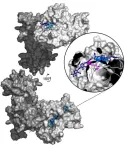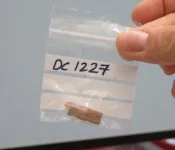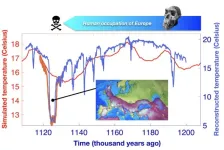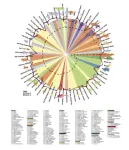(Press-News.org) Sodium, Potassium and zinc have all been promising contenders for lithium’s place in rechargeable batteries of the future, but researchers at Worcester Polytechnic Institute (WPI) have added an unusual and more abundant competitor to the mix: chloride, the richest negatively charged ions in seawater.
Xiaowei Teng, the James H. Manning professor of Chemical Engineering at WPI, has discovered a new redox chemistry empowered by chloride ions for the development of seawater green batteries.
Modern lithium-ion batteries used in various applications, including electric vehicles, can be problematic for grid storage, given their high cost and reliance on critical materials, such as cobalt, nickel, and lithium, as well as their limited geographical availability. For example, six countries own over 85% of lithium reserves on the land.
Teng and his research collaborators--Heath Turner, professor of Chemical and Biological Engineering at the University of Alabama, and Lihua Zhang, Milinda Abeykoon, Gihan Kwon, Daniel Olds, all research scientists at Brookhaven National Laboratory in New York--went beyond the limits of current green battery technology by leveraging chloride ions to empower redox chemistry of iron oxide battery materials.
Teng and his colleagues reported on the new battery chemistry in “Chloride-Insertion Enhances the Electrochemical Oxidation of Iron Hydroxide Double Layer Hydroxide into Oxyhydroxide in Alkaline Iron Batteries”, a paper published in the American Chemical Society journal Chemistry of Materials and highlighted in the supplementary front cover.
This study revealed that chloride ion insertion into Fe(OH)2 layered double hydroxide formed a Green Rust intermediate crystalline material, which assisted a one-charge transfer Fe(OH)2/FeOOH conversion reaction and improved cycling stability. This new iron redox chemistry was discovered and examined in the WPI lab. Teng and his graduate student Sathya Narayanan Jagadeesan, who is the leading author of the article, further traveled to Department of Energy User Facilities at Brookhaven National Laboratory to conduct experiments to validate the results using operandosynchrotron X-ray diffraction and high-resolution elementary mapping.
Teng and his WPI team made an aqueous battery, a small lab-scale prototype that operated in the water-based electrolyte, using electrodes made mostly from abundant elements such as iron oxides and hydroxides. While the team hasn’t calculated the cost, the use of earth-abundant materials should tip the scale in their favor, Teng says. The U.S. produces over 15 million tons of scrap iron wastes that are not recycled each year, many of which exist in the form of rust. Therefore, the reported rechargeable alkaline iron battery chemistry helps repurpose the iron rust waste materials for modern energy storage.
The research was funded by the National Science Foundation and the Department of Energy (DOE).
END
Chloride Ions From Seawater Eyed As Possible Lithium Replacement In Batteries of the Future
2023-08-10
ELSE PRESS RELEASES FROM THIS DATE:
Mechanism underlying bacterial resistance to the antibiotic albicidin revealed
2023-08-10
A new analysis shows that infectious bacteria exposed to the antibiotic albicidin rapidly develop up to a 1,000-fold increase in resistance via a gene amplification mechanism. Mareike Saathoff of Freie Universität Berlin, Germany, and colleagues present these findings August 10th in the open access journal PLOS Biology.
Bacterial resistance to antibiotics is a growing problem associated with millions of deaths around the world every year. Understanding how bacteria evolve resistance is key to developing more effective antibiotics and strategies for using them.
In recent years, albicidin has emerged as a promising antibiotic capable of killing a wide range of bacterial species ...
Researchers engineer bacteria that can detect tumor DNA
2023-08-10
Pushing into a new chapter of technologically advanced biological sensors, scientists from the University of California San Diego and their colleagues in Australia have engineered bacteria that can detect the presence of tumor DNA in a live organism.
Their innovation, which detected cancer in the colons of mice, could pave the way to new biosensors capable of identifying various infections, cancers and other diseases.
The advancement is described Aug. 11, 2023, in the journal Science. Bacteria previously have been designed to carry out various diagnostic and therapeutic functions, but lacked the ability to identify specific DNA sequences and mutations outside ...
Climate modeling reveals new insights into hominin migration and evolution
2023-08-10
In two studies, researchers demonstrate how climate modeling approaches can fill gaps in our understanding of hominin evolution and migration.
Over the last several decades, research efforts into the lives of hominins – humans and their close ancestors – have shifted from identifying fossils and artifacts to understanding the environmental and climate settings in which they lived and how these factors could have influenced hominin evolution and migration. However, like the hominin fossil record, environmental and climate records that accurately capture environmental change and span the period over which ...
New approaches enable chemical upcycling of polyethylene and polypropylene plastics
2023-08-10
In two studies, researchers present new ways to convert common waste plastics, polyethylene (PE) and polypropylene (PP), into high-value chemical products, including alcohols, aldehydes, surfactants, and detergents. The approaches provide a pathway toward creating a circular plastics economy and the ability to produce high-value chemicals more sustainably. Waste plastics are increasingly being considered a potentially abundant source of feedstock to produce valuable chemical compounds. However, some plastics, particularly polyolefin plastics like PE and PP – widely used commodity plastics that account ...
Special Issue: Australia
2023-08-10
In this Special Issue of Science, three Reviews, a Policy Forum, and a Perspective highlight Australia’s exceptional exposure to the risks of climate change and ecosystem degradation. Australia is home to Earth’s most ancient ecosystems and oldest continuous indigenous cultures, which have survived for more than 60,000 years. However, the continent’s unique ecosystems and cultural history have proved vulnerable to waves of European colonization and its associated social and environmental impacts. Ongoing climate change and the ...
Global ecosystem water use efficiency has stalled since 2001
2023-08-10
Increases in global ecosystem water use efficiency – the ratio between carbon assimilation to water evapotranspiration – have stalled since 2001 due to a rising vapor pressure deficit, according to a new study. The findings highlight one way that the adverse effects of our warming climate may undermine human reliance on nature-based climate solutions to achieve carbon neutrality. The rapid rise of atmospheric carbon dioxide (CO2) has led to substantial changes in global terrestrial carbon and water cycles. One of these impacts has been a generalized increase in ecosystem water use efficiency (WUEeco). On a global scale, WUEeco plays ...
A climate-orchestrated early human love story
2023-08-10
A new study published in the journal Science by an international team finds that past changes in atmospheric CO2 and corresponding shifts in climate and vegetation played a key role in determining when and where early human species interbred.
Modern-day people carry in their cells a small quantity of DNA deriving from other human species, namely the Neanderthals and the elusive Denisovans. Back in 2018, scientists announced to the world the discovery of an individual [Figure 1], later nicknamed Denny, who lived 90,000 years ago and who was identified as a daughter to a Denisovan father and a Neanderthal mother [Slon et al. 2018]. Denny, along with fellow mixed-ancestry ...
How a massive North Atlantic cooling event disrupted early human occupation in Europe
2023-08-10
A new study published in the journal Science finds that around 1.12 million years ago a massive cooling event in the North Atlantic and corresponding shifts in climate, vegetation and food resources disrupted early human occupation of Europe.
The study published by an international group of scientists from the UK, South Korea and Spain presents observational and modelling evidence documenting that unprecedented climate stress changed the course of early human history.
Archaic humans, known as Homo erectus moved from Africa into central Eurasia around 1.8 million years. From there on they spread towards western Europe, reaching the Iberian peninsula around 1.5 million ...
Global consortium creates large-scale, cross-species database and universal ‘clock’ to estimate age in all mammalian tissues
2023-08-10
Scientists at UCLA David Geffen School of Medicine and UCLA Health led an international research team that published two articles detailing changes in DNA – changes that researchers found are shared by humans and other mammals throughout history and are associated with life span and numerous other traits.
“We've discovered that the life spans of mammals are closely associated with chemical modifications of the DNA molecule, specifically known as epigenetics, or more accurately, methylation. In essence, mammals with longer life spans exhibit more pronounced DNA methylation landscapes, whereas those ...
Extreme cooling ended the first human occupation of Europe
2023-08-10
Paleoclimate evidence shows that around 1.1 million years ago, the southern European climate cooled significantly and likely caused an extinction of early humans on the continent, according to a new study led by UCL researchers.
Published in the journal Science, the team of researchers discovered the occurrence of previously unknown extreme glacial conditions around 1.1 million years ago. The glacial cooling pushed the European climate to levels beyond what archaic humans could tolerate, emptying the continent of human populations.
The oldest known human remains in ...






